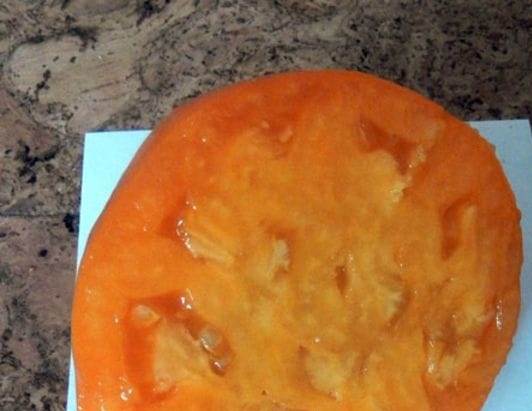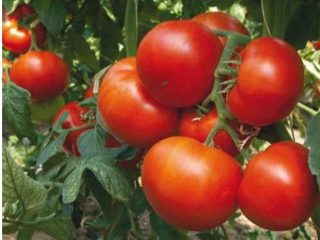Content
The Olesya tomato, unpretentious and cold-resistant, was bred by breeders from Novosibirsk. The variety has been included in the State Register since 2007 with recommendations for cultivation in all regions, both in greenhouses and in open ground. Orange fruits of medium and large size are very tasty and suitable for harvesting.
Characteristics and description of the tomato variety Olesya
The tomato plant of the Olesya variety is of an indeterminate type, and can, in favorable conditions, rise up to 2 m. In August, the tops of the stems are pinched so that the tomatoes can be successfully poured from the last bunch and have time to ripen before frost. The tall bush usually reaches 1.5-1.7 m and produces many stepsons. The stems of the Olesya tomato, according to reviews and photos of those who planted it, are strong and can withstand a bountiful harvest of fruit. The leaves are of the usual shape for tomatoes, dark green, rather large. Simple inflorescences are formed, like most indeterminate tomatoes, after 9-11 true leaves. Next, fruit clusters are formed through 3 leaves.
Producers of the variety indicate that a late tomato will ripen 116-120 days after emergence.
Description of fruits
The Olesya tomato variety, judging by reviews and photos, produces large fruits, especially if it is grown in a greenhouse. The fruit sizes are from 6-8 cm in length and 4-6 cm in diameter, weighing 155-310 g. In open ground, Olesya tomatoes are smaller, but more ovaries are laid. Weight from 90 to 270 g, average weight - 130 g. The fruits are oval-shaped, similar to plum-shaped ones, but more rounded.
The skin and pulp are intense orange when fully ripe. According to some reviews, the skin is very thin and bursts during canning. Although other housewives insist that the tomato remains intact. The structure of the pulp is tender, fleshy and dense, but juicy, there are few seeds. The authors recommend the Olesya variety for fresh consumption. The taste of orange tomato is pleasant, sweet, with balanced acidity. Tomatoes of the Olesya variety contain 3.4% sugars and 15-16% ascorbic acid.
The excellent taste and aesthetic qualities of orange tomatoes make them indispensable in summer salads and slices. Excess fruits make good raw materials for preparing winter salads. Overripe ones are used in the general mass of red tomatoes for sauces or juice. The fruits last up to 10-14 days.
Tomato yield Olesya
Late-ripening tomato varieties, which usually have a pleasant sweet taste, like Olesya tomatoes, ripen in August. Only in a heated greenhouse can you start growing tomatoes in April and get a harvest in July.
The authors of the variety indicate an average yield per 1 square meter. m – 6.4 kg. In a greenhouse, each bush produces over 2 kg of tomatoes, in open ground - 1.5-2 kg.In order for the variety to reveal its potential, the plant is formed:
- stepchildren are planted, leaving only the first stepson for the second stem, and the rest are removed;
- lead into one or, more often, into 2 stems;
- tie the stems to the supports;
- in early or mid-August, after tying the upper fruit cluster, pinch the top.
The productivity of indeterminate type tomatoes largely depends on the formation of the plant, but also on the nutritional value of the soil, timely watering, and maintaining humidity in the greenhouse.
Sustainability
According to the characteristics, the Olesya tomato can withstand short-term drops in night temperature to + 1 °C in September. The plant survives, and the fruits in open ground are covered if cold weather is expected. Tomatoes can survive frost only in a well-protected greenhouse. In order for seedlings to withstand positive but sharp changes in day and night temperatures, they are hardened off before moving into open ground. The variety can also tolerate a short period of drought, but for normal yields, tomato plants are regularly watered, keeping the soil slightly moist and loose.
Olesya tomato bushes are not infected with the yellow curl virus, as some sources claim. Plants should be treated in advance to prevent the occurrence of late blight, which often affects late tomatoes. They also systematically monitor the condition of the leaves, checking for the presence of aphids or whiteflies, the most common pests of tomatoes, especially in closed ground conditions.
Advantages and disadvantages
Attractive Olesya tomatoes, according to the photo and description, are finding more and more lovers of large-fruited and tall vegetables. Over the years of cultivation, gardeners have identified many advantages of orange tomatoes:
- medium sized fruits;
- attractive shape and color;
- pleasant soft taste;
- transportability;
- unpretentiousness to growing conditions.
The disadvantages of the selection form include:
- late ripening;
- susceptibility to fungal diseases;
- average yield;
- indeterminateness, which requires the mandatory formation of the plant.
Rules for planting and care
When caring for Olesya tomatoes, standard agricultural techniques are used.
Growing seedlings
Orange variety tomatoes are sown at a time characteristic of the region, approximately 60-65 days before planting in a greenhouse or open ground. For the first sowing, select a bowl up to 6-8 cm deep, and for picking, separate cups for each tomato with a diameter of 8-10 cm and a depth of up to 10 cm. Purchase a special substrate for seedlings if there is no soil prepared in the fall. For tomatoes, they independently collect the following composition:
- 1 part each of turf or garden soil, humus, peat or sand;
- add a quarter cup of wood ash, 1 teaspoon each of superphosphate and potassium sulfate to 10 liters of mixture.
The seeds are soaked for 15 minutes in potassium permanganate and then in some kind of growth stimulant. Some gardeners from Siberia claim that plants made from untreated seeds are more resistant to cold weather. The seeds are immersed 1 cm into the substrate, the container is covered with film and placed in a place with a temperature of 23-25 °C. After 6-7 days, the seedlings are subject to the first hardening, reducing the heat to 17-18 °C. The strengthened sprouts are transferred to a bright windowsill or under a phytolamp and moistened regularly. When the first true leaves are already growing, the tomatoes are transplanted into separate containers, pinching the central root by 1-1.5 cm.Seedlings develop well at a temperature of 23-25 °C.
Transplanting seedlings
After 55-60 days, Olesya tomato seedlings, according to the description of the variety and its characteristics, lay the first flower cluster. By this time, the containers should be taken out into fresh air for 10-14 days for hardening. Tomatoes have been planted in a greenhouse without heating since the beginning of May. It is customary to move seedlings of the variety to an open area:
- in the southern regions - from mid-April;
- in the central climate zone of Russia from May 10 to June 7;
- in the Urals and Siberia - from the middle of the last ten days of May to the second ten days of June.
Aftercare
In open ground, water after 2-3 days if there is no rain. Water is heated in the sun, 1.5-2 liters are poured under each root. In the greenhouse, water every other day, in the furrows between the rows, avoid the sprinkling method, because due to excess dampness, whitefly infection is possible. It is important to ventilate the room so that the humidity is between 65-75%. After watering, the dried soil is loosened in the first weeks to 10 cm, then superficially - up to 5-6 cm, so as not to damage the roots, and mulched. 9-12 days after planting, the bushes of tall Olesya tomatoes, according to the description and photo, are earthed up after mandatory watering to strengthen the root system, then the procedure is repeated 2 weeks later.
The variety is fed after 16-21 days. Dilute in 10 liters of water:
- 1 tbsp. l. ammonium nitrate;
- 2 tbsp. l. potassium chloride;
- 3 tbsp. l. superphosphate.
This composition is used before mass ovary. Then the fertilizer ratio is changed:
- 2 tbsp. l. superphosphate and ammonium nitrate;
- 3 tbsp. l. potassium chloride.
1 liter of fertilizer is poured under the root. It is more convenient to use complex mineral preparations.
Conclusion
The Olesya tomato bears fruit in open areas and in greenhouses and is undemanding to growth conditions. It is important to harden the seedlings, plant the shoots in time and tie up the tall stem. The average yield is compensated by the delicate taste of the fruit.
















A variety with a good pleasant taste. The seedlings are strong and resistant...tolerate transplantation almost painlessly.The downside is that in hot sunny weather the fruits burn... the leaves droop....